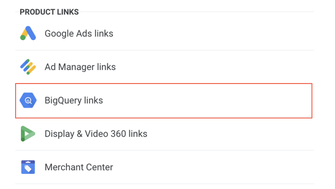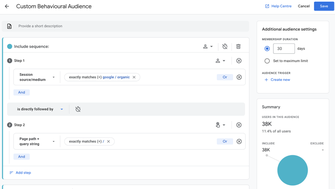How to use GA4 + BigQuery as a free CDP
We explain how you can combine the power of Google Analtyics 4 and BigQuery to create a free customer data platform to take your use of customer data to the next level.
Customer Data Platforms (CDPs) have emerged as crucial tools for organisations looking to leverage their customer data for marketing.
This lets them gain valuable insights and deliver personalised experiences to their users. However, most CDP platforms come at a price, so it’s really exciting that when you use Google Analytics 4 (GA4) and BigQuery together, almost totally free CDP-like capabilities are unlocked.
In this article, we'll explore how GA4's connection with BigQuery enhances its features to resemble those of a CDP. We'll also take a look at the benefits this brings to an organisation's paid advertising strategy.

What is a Customer Data Platform (CDP)?
A Customer Data Platform (CDP) collects data from the places that a user interacts with across an organisation, such as their website, CRM system, email or social media, and unites it in one place.
It aims to create a holistic view of each customer, enabling organisations to gain profound insights and segment their audience.
They're also great at fixing scattered data issues, making information flow smoothly between marketing, sales, and customer service.This ultimately empowers organisations to optimise their advertising efforts, tailor messages, and drive conversions.
Benefits of GA4 and BigQuery Integration for Advertising
Here's why you might want to use GA4 and BigQuery for your paid advertising.
- The GA4-BigQuery integration provides a holistic view of customers by bringing data from multiple sources into one place. This enables organisations to understand their audience better and make more data driven decisions.
- With detailed customer data and insights, organisations can create highly personalised ad experiences, tailoring ads to individual preferences and behaviours to increase the chances of conversion.
- With data from GA4 and other sources in BigQuery, it will allow organisations to track customer journeys across multiple touch points. This seamless cross-channel attribution helps identify the most effective marketing channels and optimise ad campaigns accordingly.
- BigQuery's data warehousing capabilities ensure that organisations can handle large volumes of data efficiently. This scalability and flexibility accommodate growing organisations and their evolving data needs.
Google Analtyics 4 as a CDP: How it Works
Google Analytics 4 has evolved into much more than a conventional web analytics tool. One of the key features that sets it apart from Universal Analytics is its integration capabilities with Google BigQuery.
Previously connecting Big Query to your Google Analytics account was only available to GA360 customers. However, GA4 now has a native BiqQuery connection that's available to all users.

Behavioural Audiences
Building behavioural audiences in GA4 mirrors what a CDP does. It does this through its ability to create custom audience groups.
Just like a CDP allows for segmenting customers based on their actions, GA4 allows you to build audiences and segments based on specific user behaviour.

Behavioural Audiences setup
Once you log into your GA4 account, follow these steps.
Admin > Audience > New Audience
When you're creating your new audience, you can decide what the criteria for the audience should be.
In the example above, the audience has been created from anyone that has arrived directly at the homepage from the source/medium Google/organic.
It also shows the number of users within the audience (38k) and what percentage share this audience is compared to all users (11.4%). You can change the membership duration. which by default is 30 days, to affect these results too.
Every data point in GA4 can be used to create an audience, so there are endless opportunities to analyse your users. You can choose to specify if the actions should be directly or indirectly followed by each other, and set the duration between these events.
For example, you could create an audience of users who:
- Arrive at the site from a paid campaign
- Then indirectly visit a related content page
- But don’t download the PDF on that page within 2 minutes.
It's worth noting that these audiences don’t populate retroactively. You can create segments within the reports section that do, but audiences can only be used in the reports that are created within the “Explore” section
When you save the audiences, they can be made available to use in marketing platforms such as Google Ads, as long as you have Google Signals enabled.
This allows for targeted marketing efforts and personalised experiences, similar to how a CDP helps organisations understand their audience better and deliver personalised messaging.
Unified Customer Data
By integrating GA4 with BigQuery, organisations can consolidate data from various sources. This unified dataset creates a broader view of customers, mirroring a CDP's comprehensive data integration.
When you enable the connection between GA4 and BigQuery, you’ll have to follow some simple steps in BigQuery to set up an account.
- Create a Google Analytics 4 property in your Google Analytics account.
- Ensure you have access to Google BigQuery and create a project in the Google Cloud Console.
- Link Google Analytics 4 Property to BigQuery.
- Grant Permissions in BigQuery.
You’ll also need to make sure that the Google Analytics service account has the necessary permissions to write data to your chosen BigQuery dataset.
The service account name is "[email protected]"
Once the data is flowing between GA4 and BigQuery, you can loop in your CRM data and connect the two using the User ID.
In GA4, each user is assigned a unique User ID, which can be connected to a corresponding customer ID in your CRM. This connection ensures that the data from both sources is attributed to the correct individual.
Custom Data Segmentation
The integration allows for advanced audience segmentation. Organisations can create custom segments based on specific attributes, such as behaviour, demographics, and interests.
As BigQuery collects the raw data from GA4, there is no threshold or sampling applied to the data. Furthermore, if you connect Looker Studio to BigQuery to build your report visualisations, you can avoid the API quota issue. This is something many users encounter with the native GA4 - Looker Studio connection.
Need help?
In the digital age, leveraging customer data is crucial for achieving marketing success. While Customer Data Platforms (CDPs) have long been the go-to for data unification, GA4 has bridged the gap by integrating with Google BigQuery, making it simpler to get a great picture of your users and their behaviours.
If you want to use GA4 and BigQuery as a customer data platform to leverage your audience data, get in touch via [email protected] and we’ll see how we can help.

Picking the right CMS is a crucial decision for your website, and some are better for large websites than others. We break down the best options.